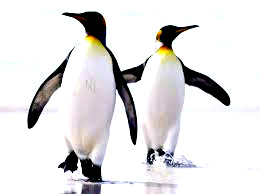The penguin is classified as a flightless seabird and belongs to the family Sphenisciformes, which includes 18 to 21 species of seabirds.
In the Southern Hemisphere, few penguins live in temperate regions and only one species lives in the equatorial region, known as the Galapagos penguin [1]. The weight of the penguin varies from 1.5 kg to 14 kg, and its length is from 43 cm to 122 cm; Penguins live on average from 6 to 30 years. [2] The penguin is a flightless waterbird that belongs to the penguin family, and lives in the southern hemisphere
, with a small number of individuals living in temperate regions, and only one species that lives at the equator. The penguin weighs from 1.5 to 14 kilograms, has a length of 43 to 122 centimeters and has a lifespan of 6 to 30 years. What do penguins eat? The diet of a penguin varies by location, species, and time of year [1]. To answer the question "What do penguins eat?" They eat all marine animals, such as fish, squid, octopus, shrimp, crabs, etc. Mother penguins feed the baby penguins by catching fish and krill in their mouths, then feeding them to their chicks. Krill is an important food for young penguins [2], as penguins are known to not have teeth to help them chew their food like other birds, but have underdeveloped spines in their mouths that help them push prey down their throat to swallow it, and the average penguin needs to be fed within months Summer for 0. 2] Birds meals vary
The penguin depends on its type and time of year, as well as where you live, but the vast majority feed on marine animals that they catch while swimming and diving, such as fish, squid, etc. What about krill: how do penguins reproduce? Most species of penguins are monogamous[2], most species reproduce once a year, and king penguins reproduce twice every 3 years. The breeding season also varies depending on the species, with the vast majority breeding in spring or summer, the Gentou penguin breeding in the winter, and the emperor penguin breeding in the fall [1]. One of the most important penguin breeding behaviors: What are the most important penguin mating behaviors? Penguin mating behaviors vary between species, but they are almost similar to each other. Penguins have many behaviors, including: - Penguin mating behaviors during mating: [3] Nest building: In general, males of penguins precede females to the mating site, and in some species, penguins build nests. The males return to the nests they previously built and modify them to make them as elegant as possible, using stones, sticks, and other items. Choice Mate: As mentioned above, the penguin is a monogamous animal. Therefore, when the females reach their breeding grounds, they are reunited with their mates from the previous year, usually a few weeks after the arrival of the males. The female makes sure of the old nest she was in the previous year, as she sits to secure herself, thus facing several nests to reach the same nest. In species that do not build nests, the female checks the quality of the song of the male penguin to choose him as a mate. Mating mechanism: after choosing a partner, courtship begins between them, then they tend to each other and communicate with each other, this ritual helps them get to know each other and find each other later. The female has a tail, which allows the reproductive openings of both to line up and thus transport sperm and mate. How does the penguin life cycle work? The benefits of a penguin life cycle vary depending on its species and species [1]. Here we can talk about the life cycle of the king penguin, for example, who lives in South America, and the life cycle of the king penguin goes through the following stages: [4] Eggs: The female king penguin lays an egg, between November and December, She and the male incubated the egg by placing it on the male's feet for 55 days. Chicks: The eggs hatch in January.

تعليقات
إرسال تعليق